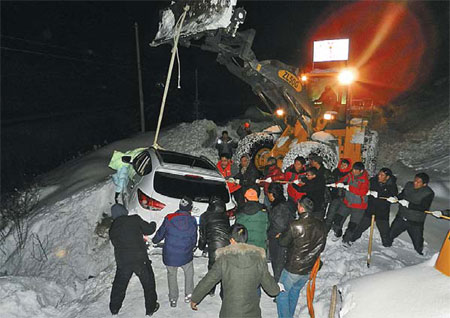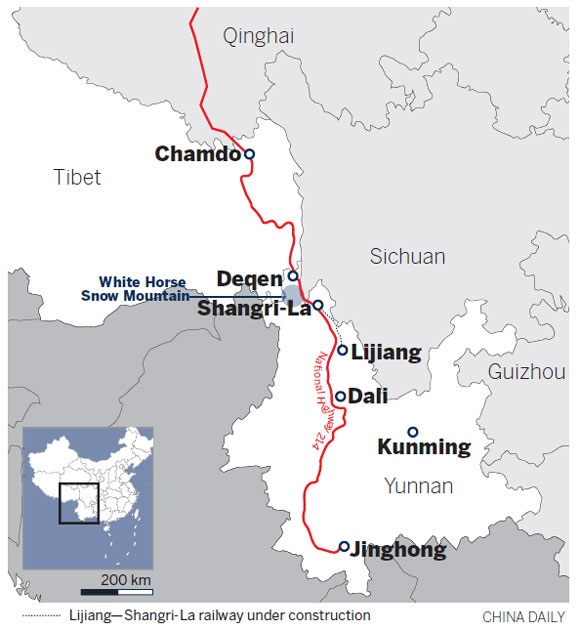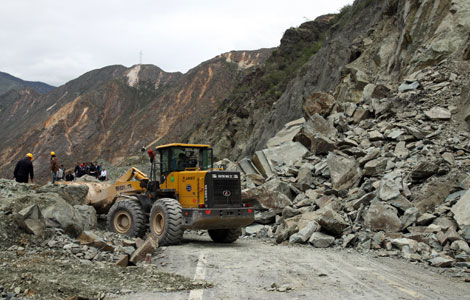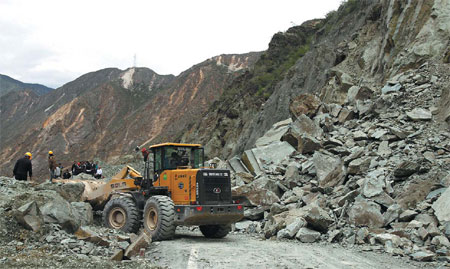keeping open the lifeline to Tibet
Updated: 2013-10-28 07:02
By Hu Yongqi and Li Yingqing in Deqen, Yunnan (China Daily USA)
|
||||||||
Highway linking the plateau a vital link, report Hu Yongqi and Li Yingqing in Deqen, Yunnan
'Hey, man, watch your back for falling rocks. There's another huge one coming down," shouted Yang Jun to the driver of an excavator clearing debris on National Highway 214.
Just a few seconds later, three large rocks, the biggest estimated at more than 10 metric tons, slammed onto the road. The driver avoided them by turning the excavator's enormous arm out of range, before starting once again on his work of breaking the stones and clearing the road.
On one side of the highway, shattered rocks lie strewn around, while on the other side, the Jinsha River rushes past. Later downstream it becomes the Yangtze River, its waters tinted by yellow soil similar to that found on the Loess Plateau in northwest China.
It's a typical scene on this high-altitude highway where hazards can come from any direction. Two trucks, smashed simultaneously by a landslide, have been left on the road to remind drivers of the potentially risky conditions.
In late October, the only signs of life were the yaks and goats that slowly wound their way between small bushes turned gray by the dust raised by passing vehicles.
On Aug 30, Diqing Tibet autonomous prefecture, in the north of Yunnan province, was hit by a magnitude-5.9 earthquake. Yang, a manager at Sichuan Hydropower Investment and Management Group, was dispatched to Shangri-La in the aftermath of the quake. Yang's company has a contract to clear the existing highway and construct a new one.
When we met, he and his colleagues had been working for more than 50 days to clear the debris. Yang said it was the toughest assignment he'd undertaken in the course of his 25-year career.
"Some of the rocks appear to be stuck to the mountainside, but they'll easily be dislodged if another tremor occurs," he said.
National Highway 214, also known as the Yunnan-Tibet Highway, runs for 3,256 km, stretching from Jinghong city in Xishuangbanna Dai autonomous prefecture in southern Yunnan to Xining city, the capital of Qinghai province. Upon completion in 1974, the road became one of the four main routes for cargo and people entering or leaving the Tibet autonomous region.
Located at an altitude of 3,300 meters, Diqing, whose 373,000 residents live on 23,870 square km of land, still relies heavily on the highway because there is no access to railways or expressways. The Deqen-Zhongdian fault line (Zhongdian county was renamed Shangri-La in 2001) is prone to earthquakes, so the area is sparsely populated - with just eight people per square km - and the locals value the highway.
The road winds up to the summit of White Horse Snow Mountain in Deqen Tibet autonomous county; at around 3,500 meters it's high above the snowline. The road only functions because of the dedication of the maintenance workers who struggle to overcome the climatic extremes during winter and summer.
A lifeline for locals
Chen Qun, director of the Diqing Bureau of Transport, said the Yunnan-Tibet Highway is a lifeline, crucial to the economic development of this eastern area of Tibet.
Every year, thousands of trucks travel the highway, carrying supplies to Chamdo, a major transport hub in the east of the autonomous region. Tibet is unable to produce commodities such as concrete, iron or steel and also lacks coal deposits or oil reserves. That means every truckload of supplies is vital to local residents, according to Zhou Yongbing, a 36-year-old driver who has been traveling the road for around a decade.
An official in Deqen county, who asked not to be named, said the poor transport facilities mean some villagers haven't left the area for three or four years and, in an place surrounded by mountains and hills, the highway has great significance for local residents.
Following an unexpected snowstorm in Deqen in early October, the larch trees on White Horse Snow Mountain turned from green to yellow, glowing golden in the sunlight that locals describe as "spicy" in their dialect. The thousands of hectares of larches looked like a sandy beach, embellished with evergreen plants against a background of snow-capped mountains.
The clean air and blue skies are welcoming and refreshing to people traversing the highway. On sunny days, the 6-meter-wide road is often blocked as people in cars and on motorbikes and bicycles pull over to take in the stunning scenery.
When the weather conditions deteriorate, however, there are few sightseers because drivers are far too concerned about the potential dangers along the zigzag highway to appreciate the natural beauty of the area.
"The scenery along the highway is famous, and a large number of visitors drive or just walk along the road to view it," said Chen. "So the safety of the road is of paramount importance."
On Oct 18, travelers stuck out their thumbs, hoping to hitch a ride from the passing vehicles for "cheap, but independent, travel" from Yunnan to Tibet. Some even said they were trying to get to Nepal and India.
Tanzen, director of the Social and Economic Institute at the China Tibetology Research Center in Beijing, said the highway is crucial to the economies of Diqing and other areas in the east of the autonomous region. "Tibet has many indigenous products that are precious to outsiders, but that means nothing without highways like the one that runs from Diqing," he said.
The work of the maintenance crews maintains a link with the outside world. It helps to widen the horizons of the Tibetans and people from other ethnic groups and enables them to take well-paid jobs in neighboring areas, he said.
"The giant trucks and the bitter cold of winter do severe damage to the highway, so the repair and maintenance work is unimaginably valuable," said Zhou.
Rocks and blizzards
Chen Qun said maintaining the section above the snowline, running from Shangri-La, the capital of Diqing, to Deqen, is the most difficult part of the job for the road teams.
The maintenance work has kept the highway open, despite the extreme weather conditions on the plateau, for more than 50 years, said Chen. The White Horse Snow Mountain nature reserve, which includes six townships around Deqen and in Weixi Lisu autonomous county, has the longest section of road - around 100 km - at an elevation of more than 3,500 meters, according to Chen.
The 70 workers at the Deqen Highway Maintenance Station are responsible for the upkeep of 340 km of the highway, including an old road from Shangri-La to Deqen.
The existing highway, which winds up to an altitude of 4,292 meters before plunging back down to the foot of the mountain, is often covered by a layer of snow, 130 centimeters deep at its worst, for half of the year.
From late October to early April, the highway snakes like a black ribbon across the white, snow-covered mountain and is particularly perilous during Chinese New Year, usually the coldest part of the year in these parts.
During his 16 years with the road team, Qi Er, head of the maintenance station, rarely stayed with his family during Chinese New Year, which is also known as Spring Festival.
Instead, he spent the most important festival for Chinese people on the "invisible road", directing men and machines as they worked to help stranded motorists. A few days before the 2008 Chinese New Year, more than 600 vehicles were stranded on the mountain and so Qi Er rushed to their aid.
"It was the coldest winter I have ever known. All the trees were crushed by the snow and ice. At night, blizzards made it difficult to identify the road and one false step might have sent us tumbling into the valley," he recalled.
Conditions were so bad that the maintenance workers could barely stand the icy winds and jagged flakes of snow that cut their faces like sharp knives. After just a few minutes of work, the men were unable to feel their cheeks.
"I had five or six veteran drivers for the giant snow plows, because they had a clear mental image of the road. Without that knowledge, they would have gone over the edges of the cliffs as they negotiated the wider turns," said Qi Er.
In one stranded truck, the workers discovered a driver with acute hypothermia, so they covered his frozen limbs with a thick coat. "If you hadn't come and rescued us, we might have died during the night," said the driver's father, who was also in the truck, in a mixture of Tibetan and Chinese.
The wide temperature fluctuations between day and night meant that melted snow flowed onto the reclaimed road during daylight hours, only to freeze again at night. Sometimes the layer was as thick as 40 cm. On one 100-km stretch of road, a lack of industrial salt and melting agents meant the workers were forced to break the ice with pickaxes, according to Zou Yanpeng, 23, a member of the road crew. "Each strike left a white crack in the ice, but the flying particles hit our cheeks with the force of bullets," he said.
A new highway
Zhou said that the heavy loads he carries mean that he often uses water to cool the wheel bearings on his truck with water. On winter nights, however, surface water turns to ice, making progress even more dangerous. "You can't use the brakes at night because of the ice, because your vehicle might flip over," he said.
To make the journey less risky, the Diqing government employed Sichuan Hydropower Investment and Management Group and other companies to construct a new highway that will run parallel to the existing one. The Shangri-La-Deqen Highway, with total investment of 6.52 billion yuan ($1.07 billion), will be the highest of the 52 national highways in the province. By the end of September, the project had already eaten up 5.3 billion yuan of the budget.
When the new highway is finally finished, the distance by road between the county seats will be shortened to 152 km and the journey time by bus will be reduced by two hours, from six to four, according to the transport bureau. A series of tunnels will also result in fewer twists and turns along the route.
When it comes to large infrastructure projects, such as the new highway, Diqing has been plagued by low temperatures, the thin atmosphere and its distance from production bases.
"It doesn't matter how hard the work is, we have to complete the project in accordance with the contract," said Yang.
Contact the writer at huyongqi@chinadaily.com.cn
Guo Anfei contributed to the story.
|
Above: An excavator clears debris on National Highway 214, also known as the Yunnan-Tibet Highway, which runs for 3,256 km. Hu Yongqi / China Daily Below: This 2012 photo shows workers moving a car that was trapped by a snowstorm on the high-altitude highway. Provided to China Daily |


(China Daily USA 10/28/2013 page7)

 Serena beats Li Na for WTA title
Serena beats Li Na for WTA title
 Nuclear submarine fleet comes of age
Nuclear submarine fleet comes of age
 5 pharmacies begin to sell baby formula
5 pharmacies begin to sell baby formula
 The suave style of America's dapper dynasty has arrived
The suave style of America's dapper dynasty has arrived Mother and four children stabbed to death in New York
Mother and four children stabbed to death in New York
 China Fashion Week S/S 2014: day 2
China Fashion Week S/S 2014: day 2
 Demonstrators protest against govt surveillance in US
Demonstrators protest against govt surveillance in US
 Where art thou, my love?
Where art thou, my love?
Most Viewed
Editor's Picks
|
|

|

|

|

|
Today's Top News
ABC apologizes for offensive words on Chinese
3 die after car crash at Tian'anmen Square
NQ Mobile hits back after US stock plunge
Jewelry exhibit dazzles Southern California
Obama aware of spying on Merkel: German paper
High speed versus history
States gear up for symposium
Cousin killed mom, 4 kids
US Weekly

|

|








